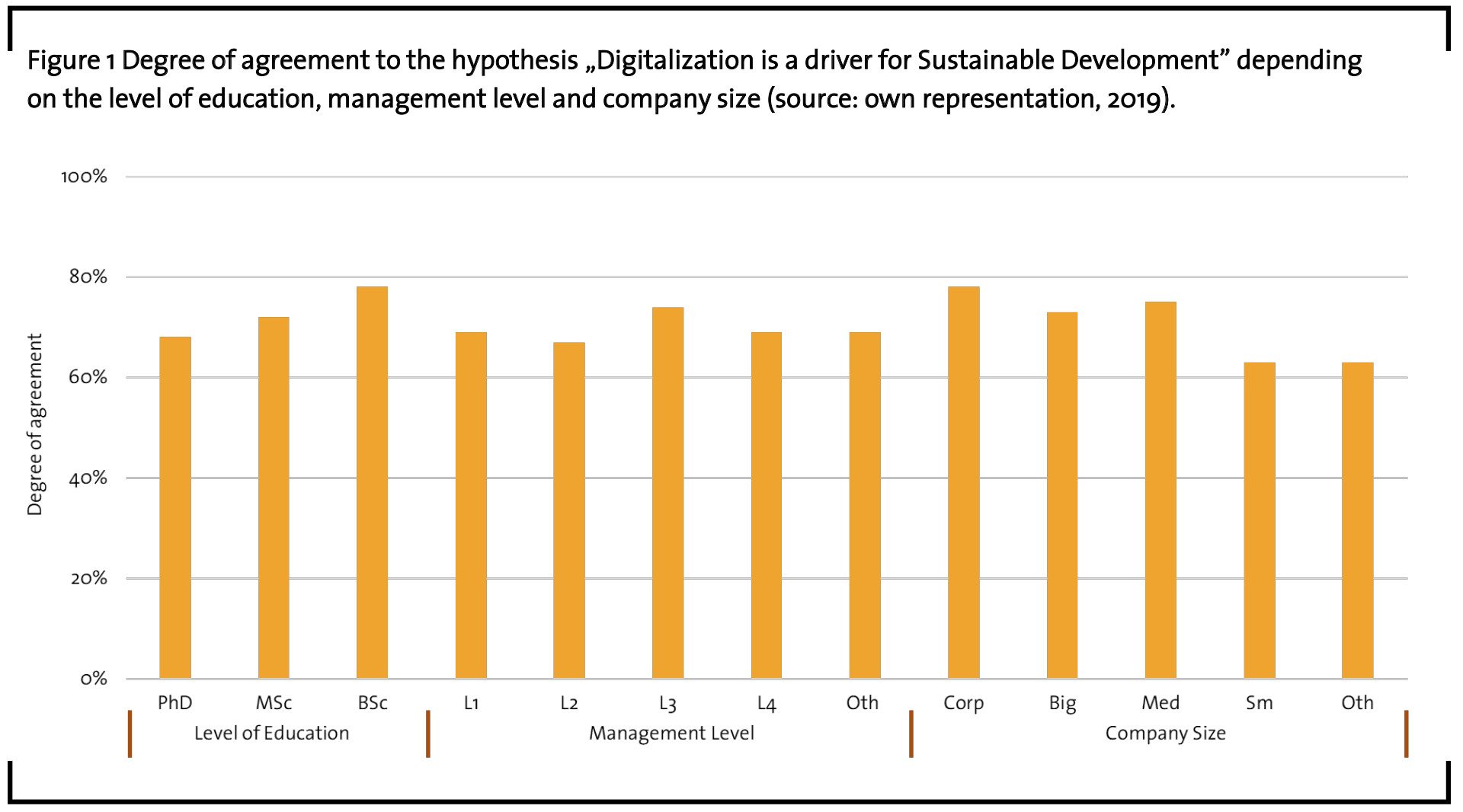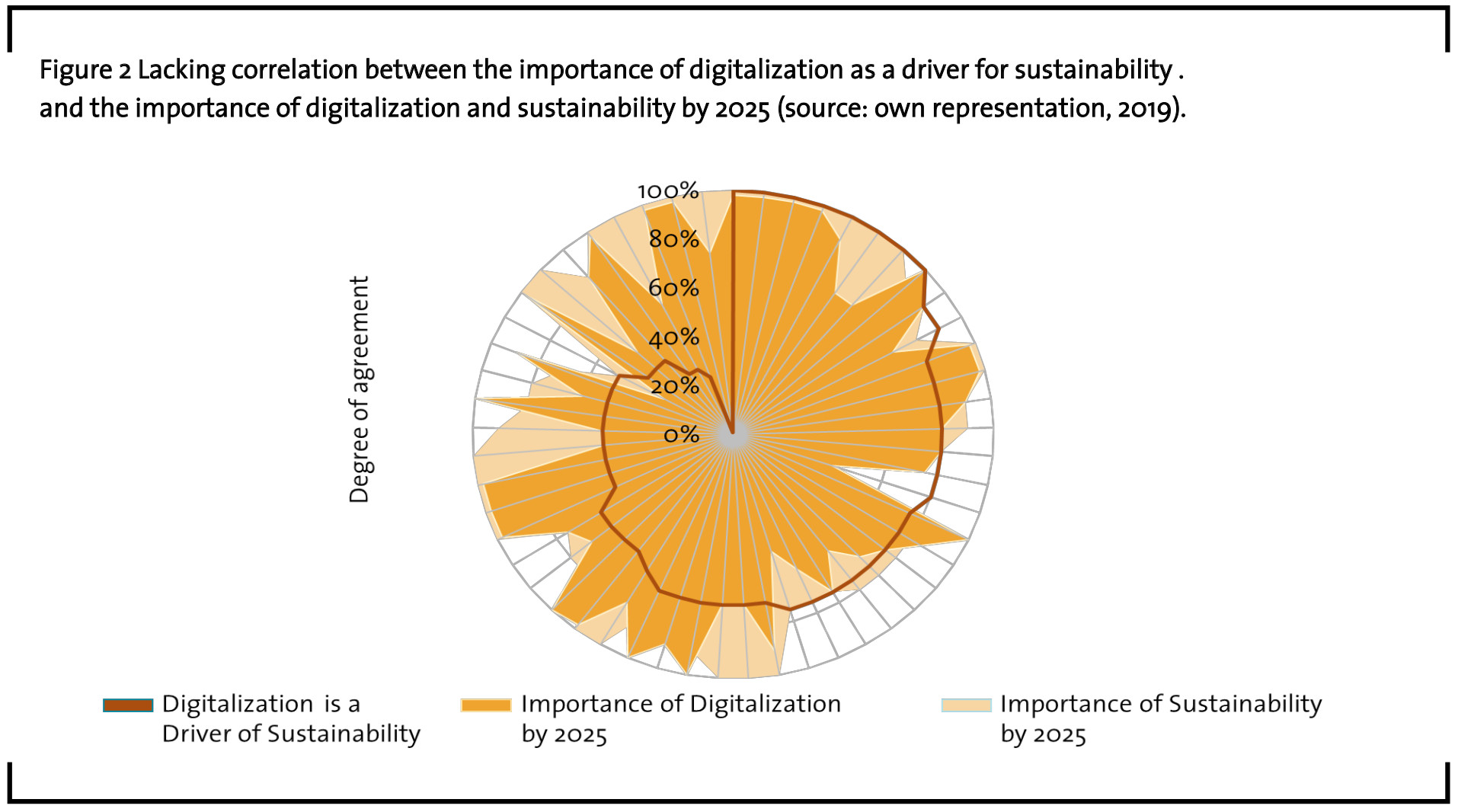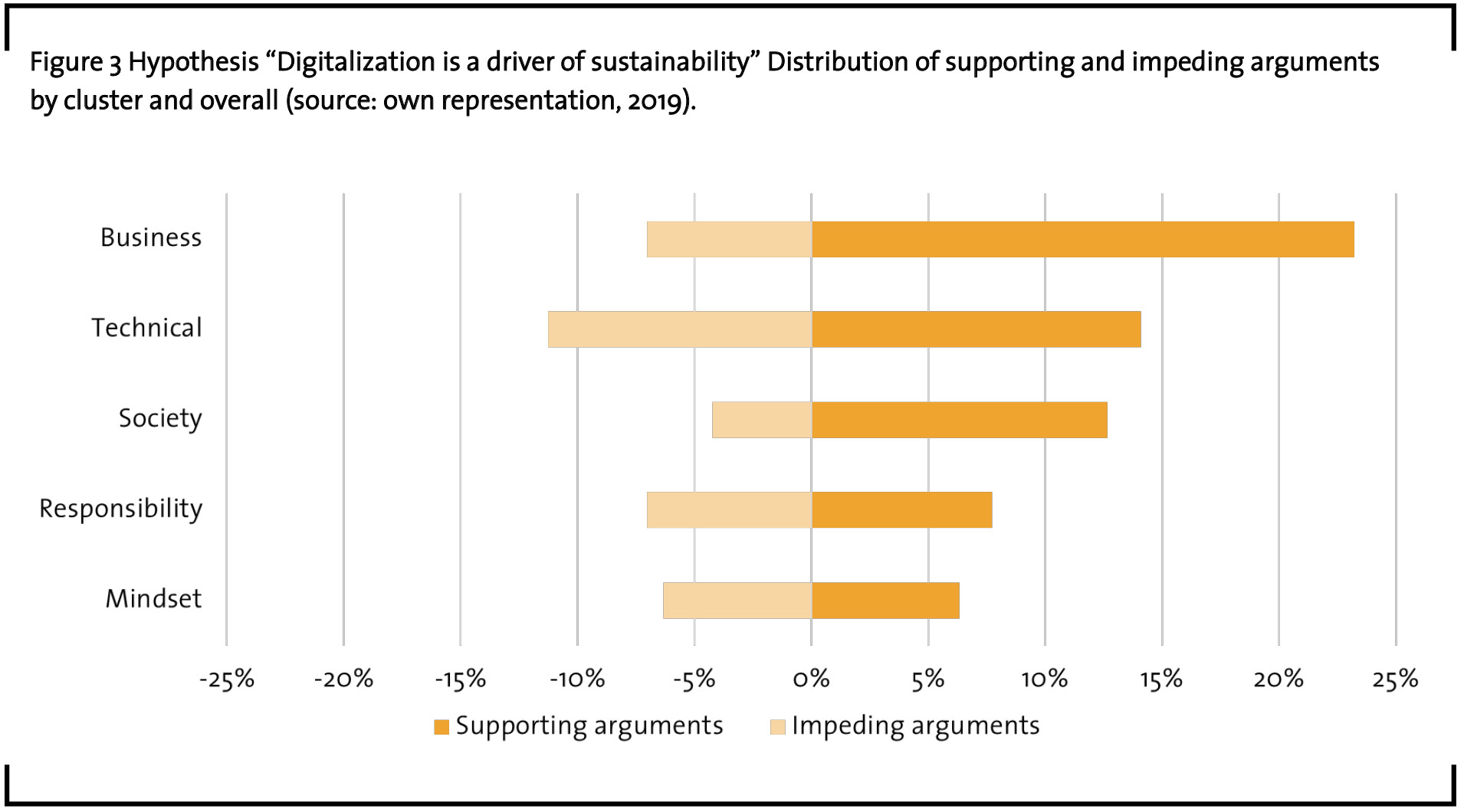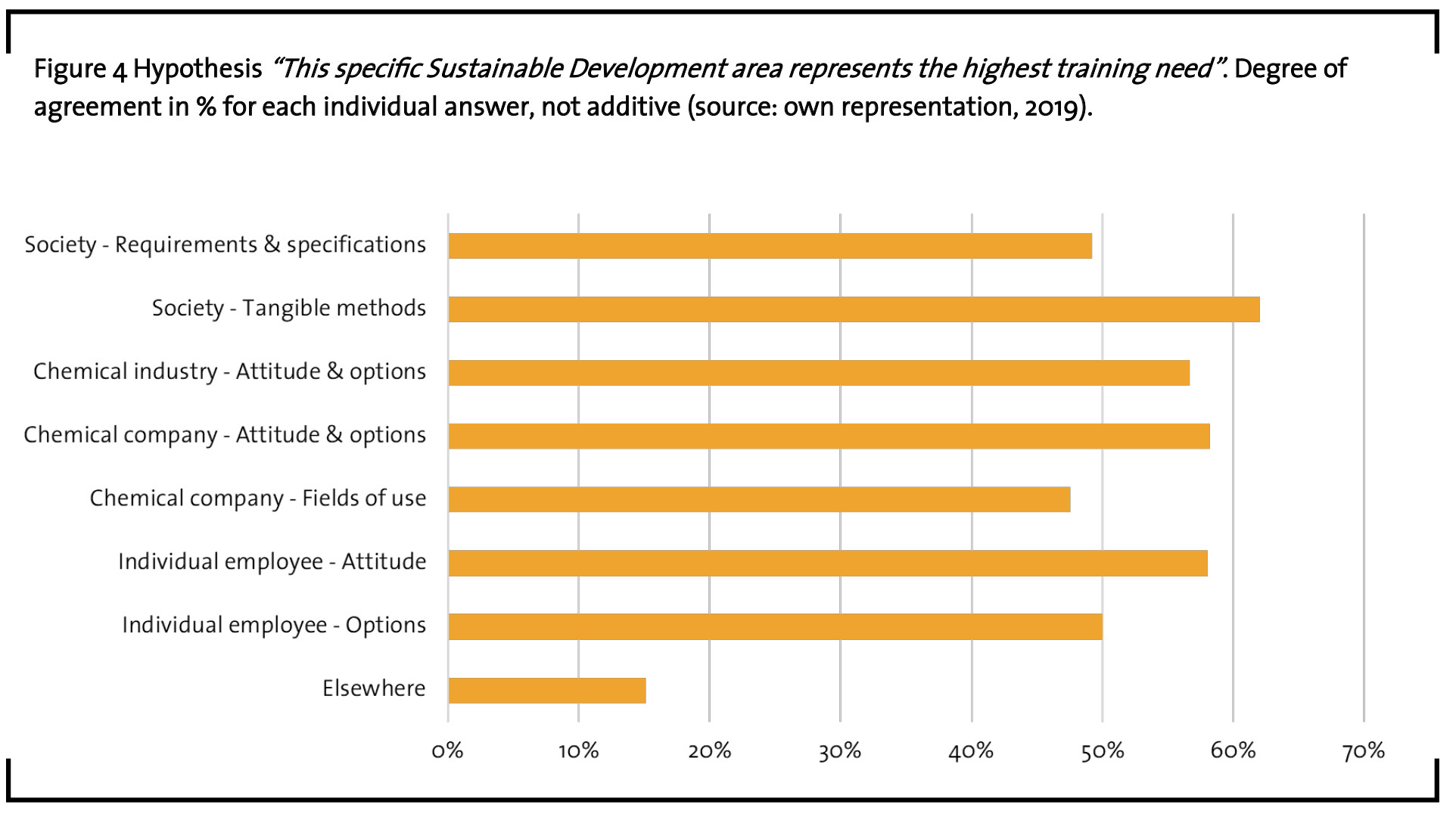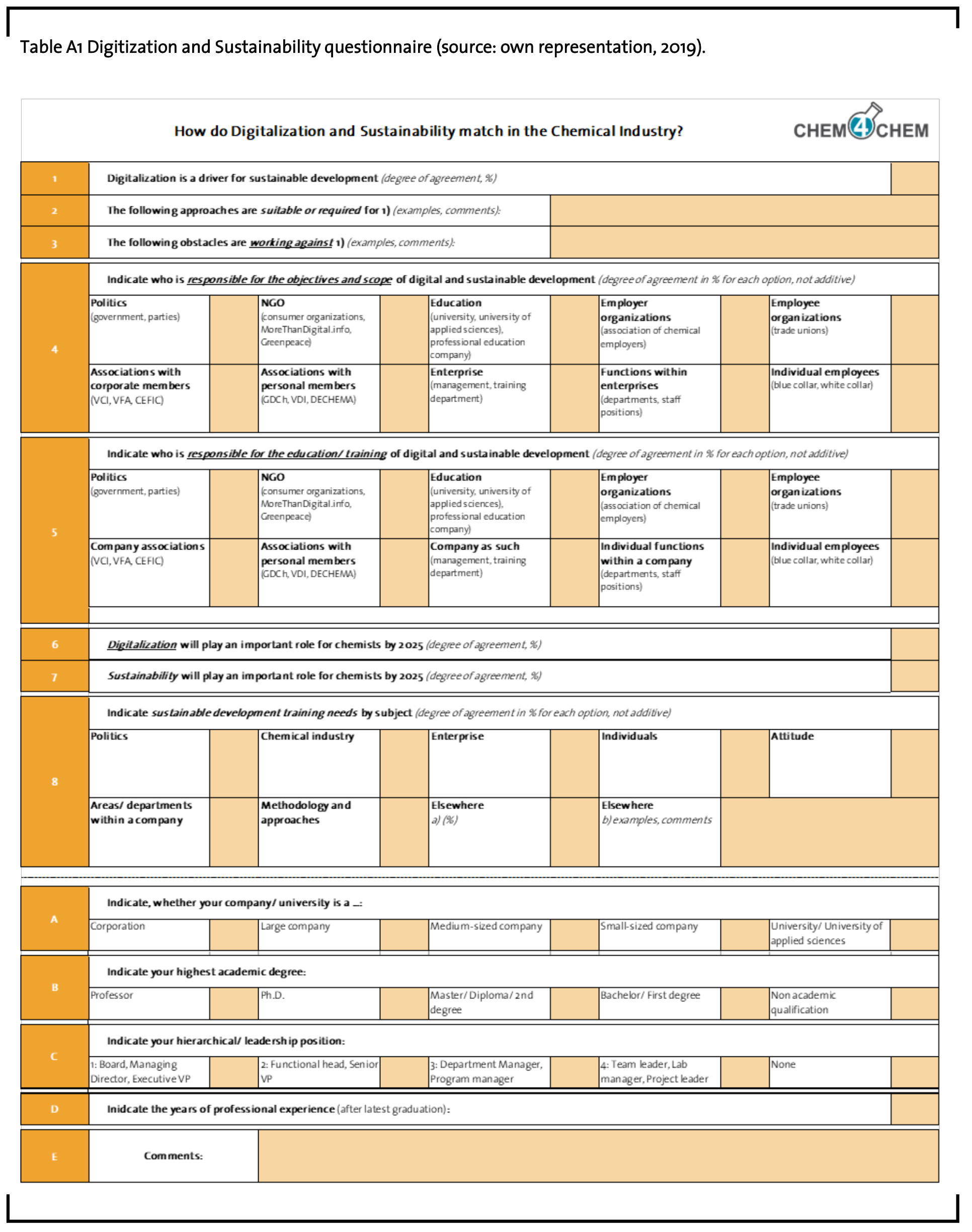Shaping digital sustainable development in chemical companies
Abstract
Both, digitalization and sustainable development are two megatrends with significant impact on the chemical industry in Germany through to 2025, according to a recent survey among 60 chemists. Digitalization is as seen a driver for sustainable development, even though there is no quantitative correlation in the importance of the two megatrends. When implementing Corporate Digital Sustainable Responsibility (CDSR) chemical companies need to find the right balance between business, technology, society, responsibility and mindset-related facets that chemical practitioners refer to when arguing in favor of digitalization being a driver for sustainability or against it.
1 Introduction
Germany’s chemical industry has taken a leading role in Responsible Care (VCI, 2011) – nowadays referred to as Sustainable Development (Sachs, 2015) – since about 25 years. Digitalization, a second, steeply evolving megatrend, is not new either. However, its breakthrough in the chemical industry has begun only recently, marking the beginning of Digital Sustainable Development (DSD) (RNE, 2018). An empirical survey among 60 chemists identifies some preconditions and obstacles for “Corporate Digital Sustainable Responsibility”, the extended corporate governance (Werder, 2018), Digital Sustainable Development, the process to make it happen, and ultimately the desired Sustainable Development Goals (United Nations, 2015).
2 Progress of sustainable development in the chemical industry
The origin of sustainability is closely connected to major accidents, e.g. at Seveso (Kramer et al., 2019), Bhopal (Eckerman and Børsen, 2018), Houston Chemical Complex (U.S. Department of Labor, 1990) and Exxon Valdez (Cohen, 1995) in the 1970s and 1980s. In the mid -1980s, the global chemical industry took counter action in response to these disasters and to gain back its ruined trustworthiness. Today, sustainability is subject of numerous multistakeholder initiatives like Responsible Care (VCI, 2019, I, II; Delmas and Montiel, 2008; King and Lenox, 2000), Together for Sustainability (TfS, 2019), Chemie3 (Chemie3, 2019), Platform for Accelerating the Circular Economy (PACE, 2019) and Alliance to End Plastic Waste (AEPW, 2019), and an integral element of the strategy of many big chemical companies (BASF, 2019; Clariant, 2019; Evonik, 2019; Linde, 2019; Wacker, 2019, I). In this decade, chemists and chemical engineers have developed first technically and – at least partially – economically feasible industrial-scale approaches for product redesign, reuse, mechanical and chemical recycling (Werner and Mertz, 2016; Johnson, 2018; Stark, 2019; Stephan, 2019; Strathmann, 2019). The chemical industry is on a good way to achieve the desired Sustainable Development Goals and by 2050 will likely be able to be carbon neutral (VCI, 2019, III).
3 Progress of digitalization in the chemical industry
Unlike Sustainable Development, digitalization in the chemical industry is still in its early stages. Since about 5 to 10 years, bigger rather than mid-size chemical companies have begun to leverage information and communication technology, electronics, and the experience of automotive industries with digital technologies and applications (DECHEMA, 2016). Many of them have appointed Chief Digital Officer(s) whose primary task is to define and execute their company’s digital transformation roadmap (Schmidt-Stein, 2018; Wacker, 2019, II; BusinessTech- Company, 2019, I to VI). Still, the emphasis of the digital transformation roadmap is often on technical aspects. True Corporate Digital Responsibility (CDR) needs to go far beyond, e.g. including compliance with legal obligations, digital ethics, interactions with society, chemical suppliers and customers, and the enablement of employees for chemical industry 4.0 with its modified jobs and competences (Keller, 2018; BAVC, 2018; Lade, 2019).
4 Corporate digital sustainable responsibility, a feasible composite?
Can CDSR facilitate chemical companies to exploit potential synergies between the two megatrends, sustainability and digitalization, while striving to fulfill their Sustainable Development Goals? In this context CDSR in the chemical industry can be defined “an embryonic concept aiming at seamlessly integrating the two time-shifted and often independently managed approaches of CSR and CDR in order to resolve de facto and potential conflicts of interest to achieve a company’s SDGs”. Here are some examples of these conflicts:
- A blockchain system negates the risk of trusting a single organization through distributed ledgers and reduces overall costs and fees of all kind of transactions by cutting out intermediaries and third parties. However, its required resources have significantly increased in the last few years. It currently consumes more energy than many countries, such as Denmark, Ireland, and Nigeria (Binance Academy, 2019).
- Super computers offer a quantum leap in computing power, e.g. 1 to 2 quadrillion floating- point operations or 1 to 2 petaflops per second. However, its electricity consumption at full capacity is approximately 600 kilowatts, and the water-cooling system requires up to 60,000 liters of water per hour (BASF, 2018).
- A simultaneous digital and sustainable transformation impacts a chemical company’s future revenue and profit, but also public reputation, core values, culture, business model, technologies, products, services and employees, i.e. financial and nonfinancial dimensions. If mainly financial key performance indicators, e.g. the Return on Investment (ROI) for the transformation and the Return on Capital Employed (ROCE) for the ongoing business, remain the benchmark for investors and shareholders, business cases are instrumental, however rarely suitable to base not primarily financial decisions on.
The authors have undertaken an empirical survey among 60 chemists in the chemical industry in Germany to identify the relative importance of sustainability and digitalization by 2025. They look at mutual interdependencies and potentially missing competences required to pursue CDSR .
Participants represent different levels of education (Bachelor, Master, PhD), years on duty, company size (corporation, big, mid-size and small company) and management level (1 through to 4). The survey is hypotheses-based, with respondents indicating their degree of agreement with each proposed hypothesis, using a percentage scale.
The first hypothesis “By 2025 Digitalization will play a major role for chemists and engineers” achieves 83% level of agreement (sample size 56). The distribution of responses is surprisingly homogenous. There is no trend between the responses and the level of education, years on duty, company size, and management level.
78% level of agreement (sample size 56) is a clear indication that also “Sustainability will play a major role by 2025 for chemists and engineers”. The pattern of responses is almost identical with that of the role of digitalization by 2025.
The average level of agreement that “Digitalization is a driver for Sustainable Development” scores at 70% (sample size 53, Figure 1). This view is very consistent within each and across all clusters.
In addition, 53 data sets including values for each of the three hypotheses were sorted in declining order choosing “Digitalization is a driver of sustainability” as lead parameter, shown as solid line in Figure 2. The depending parameters “importance of digitalization” and “importance of sustainability” are displayed as radar charts underneath. The heterogeneity of the diagram corresponds well with poor correlation coefficients of -0.10 in case of digitalization and +0.07 regarding sustainability.
To understand the full bandwidth of related comments from 100% euphoria to 100% skepticism, all comments made were classified in five clusters: business, technical, society, responsibility and mindset. Within each cluster responses were distinguished by supporting and impeding notions. The number of comments in each (sub-)cluster was divided by the total number to calculate comments’ relative frequency. (Figure 3).
Business cluster: Key arguments that “Digitalization is a driver of sustainability” include the better control of sustainabilityrelated technical and management processes and energy management, all leading to higher technical and human resource efficiency and bottom-line improvements. Major concerns address data availability, format, integrity, and security and management decision-making timeliness and effectiveness.
Technical cluster: On the positive side, benefits through big data and artificial intelligence to drive sustainable processes, products etc. dominate by far. Excessive energy consumption, high dependency on state-of-the-art IT infrastructure and the ability to handle giant quantities of data are the top concerns.
Society cluster: Respondents are – with few exceptions – aware of the driving role of politics, educational institutions and the chemical industry in defining and providing boundary conditions for DSD. There is considerable skepticism that educational institutions assume sufficient responsibility by not including digitalization and sustainability comprehensively enough in their curricula.
Responsibility cluster: Respondents consider clear responsibilities instrumental for DSD. Only 20% see their company in charge, not a clear vote for “corporate responsibility”. The lack of commitment to digitally enabled sustainable chemical and management processes and management’s hesitation to invest in required training are the two main concerns. 80% of respondents believe DSD responsibility is primarily with politics and educational organizations.
Mindset cluster: Only 12% of all comments address the attitude of managers and employees. Leadership by example and individual freedom to act are seen instrumental for DSD. The biggest concern addresses low willingness and readiness across all levels of the company, from shop floor to C-level, to cope with change associated with DSD.
In summary, regardless which role digitalization and sustainability will play by 2025, 58% of the participants (degree of agreement ≥ 67%) are strong believers that digitalization is a key enabler for DSD, 32% (agreement between 34% and 66%) have mixed feelings, and 9% (agreement ≤ 33%) see no or a limited driving role of digitalization.
DSD is significantly affecting chemists’ job profiles, required skill sets and training needs. Training needs in the context of digitalization (Keller, 2018; Gruß, 2018; Lade, 2019) and those addressing sustainability (Keller and Knoll, 2020; ILO 2019; Graf and Reuter, 2017; ILO and CEDEFOP, 2011) have been defined. Contrary to digitalization skills, respondents consistently claim (degree of agreement between 48% and 62%, Figure 4) that there is no single highest priority for sustainability-related training. Instead, training covering requirements, specificdocations, methods, applications, attitude and options to act for each area – society, company and individual chemists, is required. 68% of the participants request their company to take primary responsibility for subject specific training in the context of Sustainable Development, which stands in conflict with the low overall responsibility (20%).
5 Conclusions
By 2025 digitalization (83% agreement) and sustainability (78% agreement) will be even more instrumental elements of Sustainable Development in Germany’s chemical industry than today, as the results from the empirical survey among 60 chemists suggest. 70% agreement to the hypothesis “Digitalization is a driver of sustainability” and the in-depth evaluation of respondents’ comments reveal key input for Corporate Digital Sustainable Responsibility.
Firstly, there is no quantitative correlation between the importance of digitalization and sustainability by 2025 and the ability of digitalization to drive sustainability. Secondly, chemists already have an extensive repertoire of ideas supporting Corporate Digital Sustainable Responsibility and counter arguments impeding it. Thirdly, there are major concerns regarding scope and maturity of digital and social responsibility competences required for Sustainable Development.
A balanced technology-, people-, and society -oriented Corporate Digital Sustainable Responsibility is required to drive the process of Digital Sustainable Development, which, in turn, helps to achieve Digital Sustainable Development Goals.
References
AEPW (2019): Alliance to End Plastic Waste , available at https://endplasticwaste.org/, accessed at 18 October 2019.
BASF (2019): BASF-Bericht 2018, available at https://bericht.basf.com/2018/de/ serviceseiten/downloads/files/ BASF_Bericht_2018.pdf, accessed at 18 October 2019.
BASF (2018): Digitalization in R&D – Meet Quriosity, available at https://www.basf.com/ global/de/who-we-are/innovation/our-way-toinnovations/ supercomputer.html, accessed at 18 December 2019.
BAVC (2018): Mithalten durch Mitarbeiter, available at https://www.chemiearbeitgeber. de/digitalisierung/lernen-fuer-diedigitalisierung/, accessed at 18 October 2019.
Binance Academy (2019): Blockchain Advantages and Disadvantages, available at https:// www.binance.vision/blockchain/positives-andnegatives- of-blockchain/, accessed at 18 December 2019.
BusinessTech-Company (2019, I): Wie setzt der BASF CDO die Digitalisierung um?, Chief- Digital-Officers.com, available at https://chiefdigital- officers.com/de/wie-setzt-der-basf-cdodie- digitalisierung-um/, accessed 18 October 2019.
BusinessTech-Company (2019, II): Wie setzt der Henkel CDO die Digitalisierung um?, Chief- Digital-Officers.com, available at https://chiefdigital- officers.com/de/wie-setzt-der-henkelcdo- die-digitalisierung-um/, accessed 18 October 2019.
BusinessTech-Company (2019, III): Wie setzt der Bayer CDO die Digitalisierung um?, Chief- Digital-Officers.com, available at https://chiefdigital- officers.com/de/wie-setzt-der-bayer-cdo -die-digitalisierung-um/, accessed 18 October 2019.
BusinessTech-Company (2019, IV): Wie setzt der Merck CDO die Digitalisierung um?, Chief- Digital-Officers.com, available at https://chiefdigital- officers.com/de/wie-setzt-der-merckcdo- die-digitalisierung-um/, accessed 18 October 2019.
BusinessTech-Company (2019, V): Wie setzt der Linde CDO die Digitalisierung um?, Chief- Digital-Officers.com, available at https://chiefdigital- officers.com/de/wie-setzt-der-linde-cdo die-digitalisierung-um/, accessed 18 October 2019.
BusinessTech-Company (2019, VI): Wie setzt der Covestro CDO die Digitalisierung um?, Chief -Digital-Officers.com, available at https://chiefdigital- officers.com/de/wie-setzt-der-covestrocdo- die-digitalisierung-um/, accessed 18 October 2019. Chemie3 (2019): Chemie3 – Die Nachhaltigkeitsinitiative der deutschen Chemie, available at https://www.chemiehoch3.de/home.html, accessed at 18 October 2019.
Clariant International AG (2019): Integrierter Bericht 2018, available at http:// reports.clariant.com/2018/integrated-report/ servicepages/downloads/files/ integrierter_bericht_clariant_ar2018.pdf, accessed at 11 October 2019.
Cohen, M. J. (1995): Technological Disasters and Natural Resource Damage Assessment: An Evaluation of the Exxon Valdez Oil Spill, Land Economics, 71 (1), 65-82.
DECHEMA (2016): Digitalisierung in der Chemieindustrie, available at https://dechema.de/ dechema_media/Downloads/Positionspapiere/ whitepaper_digitalisierung_final-p- 20003450.pdf, accessed at 18 October 2019.
Delmas, M., Montiel, I. (2008): The Diffusion of Voluntary International Management Standards: Responsible Care, ISO 9000, and ISO 14001 in the Chemical Industry, Policy Studies Journal, 36 (1), p. 65-93.
Eckerman, I., Børsen, T. (2018): Corporate and Governmental Responsibilities for Preventing Chemical Disasters: Lessons from Bhopal, HYLE – International Journal for Philosophy of Chemistry, 24, p. 29-53.
Evonik Industries AG (2019), Nachhaltigkeitsbericht 2018: Zukunftsfähigkeit ist unser Geschäft, available at https:// corporate.evonik.com/downloads/corporate% 20responsibility/ evonik_nachhaltigkeitsbericht_2018.pdf, accessed at 18 October 2019.
Graf, S., Reuter, K. (2017): Greening der Berufe und nachhaltige Arbeitswelt: Auf dem Weg zu einer kohlenstoffarmen und ressourceneffizienten Wirtschaft, Qualitative Studie des UnternehmensGrün e.V., available at https:// www.gruene-arbeitswelt.de/images/PDFs/ Studie_Greening-der-Berufe.pdf, accessed at 20 October 2019.
Gruß, A. (2018): Berufe 4.0 – neue Techniken erfordern neue Kompetenzen, CHEManager online, available at https://www.chemanageronline. com/themen/personal/berufe-40-neuetechniken- erfordern-neue-kompetenzen, accessed at 18 October 2019.
ILO, CEDEFOP (2011): Skills for green jobs: A global view, Synthesis report based on 21 country studies, 1st ed., Geneva, available at https:// www.ilo.org/wcmsp5/groups/public/— dgreports/—dcomm/—publ/documents/ publication/wcms_159585.pdf, accessed 21 October 2019.
ILO (2019): Skills for a greener future: Key findings, 1st ed., Geneva, available at https:// www.ilo.org/wcmsp5/groups/public/— ed_emp/—ifp_skills/documents/publication/ wcms_709121.pdf, accessed 21 October 2019.
Johnson, J. (2018): Ineos joins in PS recycling project, Plastic News Europe, available at https://www.plasticsnewseurope.com/ article/20180920/PNE/180929995/ineos-joinsin- ps-recycling-project, accessed at 18 October 2019.
Keller, W. (2018): Berufe 4.0 – Wie Chemiker und Ingenieure in der digitalen Chemie arbeiten, available at https://www.gdch.de/ fileadmin/downloads/ Netzwerk_und_Strukturen/Fachgruppen/ Vereinigung_fuer_Chemie_und_Wirtschaft/ whitepaper_initiative_berufe_4.0_2018.pdf, accessed at 18 October 2019.
Keller, W., Knoll, K. (2020): Anforderungen und Kompetenzen für die neue, nachhaltige und digitale Arbeitswelt in der Chemie- und Pharmabranche, in: Bertelsmann Stiftung (ed.), CDR Booksprint, 1st ed., Bertelsmann Verlag, Gütersloh.
King, A. A., Lenox, M. J. (2000): Industry Self- Regulation Without Sanctions: The Chemical Industry’s Responsible Care Program, Academy of Management Journal, 43 (4), p. 698-716.
Kramer, P., Braun, M., Bendels, M. H. K. (2019): Der Chemieunfall von Seveso, Zentralblatt für Arbeitsmedizin, Arbeitsschutz und Ergonomie, 69 (5), p. 319-326.
Lade, O. (2019): Digitalization in the Process Industries: Humans as Success Factor in Production, Capgemini, available at https:// www.capgemini.com/2019/10/digitalization-inthe- process-industries-humans-as-successfactor- in-production/, accessed at 18 October 2019.
Linde Group (2019): Corporate Responsibility, available at https://www.the-lindegroup. com/de/corporate_responsibility/ index.html, accessed at 11 October 2019.
PACE (2019): Platform for Accelerating the Circular Economy, available at https:// www.acceleratecirculareconomy.org/, accessed at 18 October 2019.
RNE (2018): sustainable_AND_digital: Sustainable development as the framework for digital transformation, Recommendation of the German Council for Sustainable Development (RNE) to the German federal government, available at https:// www.nachhaltigkeitsrat.de/wp-content/ uploads/ 2019/01/20190121_RNE_Recommendation_ sustainable_ development_as_the_framework_for_digita l_transformation.pdf, accessed at 21 October 2019.
Sachs, J. D. (2015): The age of sustainable development, 4th ed., Columbia University Press, New York, Chichester, West Sussex.
Schmidt-Stein, M. (2018): Wacker Chemie: Internationale Digitalprojekte „nicht auf einen Schlag“ ausrollen, CDO Insight, available at https://www.cdo-insight.com/organisation/ wacker-chemie-internationale-digitalprojektenicht- auf-einen-schlag-ausrollen-241/, accessed at 18 October 2019.
Stark, A. (2019): Covestro entwickelt Konzept zur Wiederverwertung von Polycarbonat, PROCESS, available at https:// www.process.vogel.de/covestro-entwickeltkonzept- zur-wiederverwertung-vonpolycarbonat- a-873245/?cmp=nl- 98&uuid=5F934058-7AE2-42B1- 8E2B83C6D6FAB5BE, accessed at 14 October 2019.
Stephan, D. (2019): Naphta aus dem gelben Sack? – So kann Chemisches Recycling aus Plastikmüll Rohbenzin machen, PROCESS, available at https://www.process.vogel.de/naphtha-ausdem- gelben-sack-so-kann-chemischesrecycling- aus-plastikmuell-rohbenzin-machena- 818828/, accessed at 15 October 2019.
Strathmann, S. (2019): Circular Economy – Grundlage einer nachhaltigen Verpackungsstrategie, available at https://www.vci.de/ ergaenzende-downloads/2019-02-15-vciworkshop- zirkulaere-wirtschaft-vortrag-05- strathmann-henkel.pdf, accessed at 11 September 2019.
TfS (2019): Together for Sustainability, available at https://tfs-initiative.com, accessed at 18 October 2019.
United Nations (2015): Transforming our World: The 2030 Agenda for Sustainable Development, available at https:// sustainabledevelopment.un.org/content/ documents/21252030%20Agenda%20for% 20Sustainable%20Development%20web.pdf, accessed at 20 October 2019.
U.S. Department of Labor (1990): Phillips 66 Company Houston Chemical Complex Explosion and Fire: A Report to the President, available at https://ncsp.tamu.edu/reports/phillips/ first%20part.pdf, accessed at 18 October 2019.
VCI (2011): Gestartet als Idee – angekommen als Erfolg, available at https://www.vci.de/vci/ downloads-vci/responsible-care-dieentwicklung- einer-initiative.pdf, accessed at 21 October 2019. VCI (2019, I): Responsible Care, available at https://www.vci.de/nachhaltigkeit/responsible -care/uebersichtsseite.jsp, accessed at 11 October 2019.
VCI (2019, II): Responsible-Care-Bericht 2018, available at https://www.vci.de/vci/downloads -vci/publikation/responsible-care-bericht- 2018.pdf, accessed at 18 October 2019.
VCI (2019, III): Auf dem Weg zu einer treibhausgasneutralen chemischen Industrie in Deutschland, available at https://www.vci.de/ vci/downloads-vci/publikation/2019-10-09- studie-roadmap-chemie-2050- treibhausgasneutralitaet-kurzfassung.pdf, accessed at 21 October 2019.
Wacker Chemie AG (2019, I): Nachhaltigkeitsbericht 2017/2018, available at https:// berichte.wacker.com/2018/ nachhaltigkeitsbericht/serviceseiten/ downloads/files/gesamt_wacker_csr1718.pdf, accessed at 18 October 2019.
Wacker Chemie AG (2019, II): Taking Changes Together: Wacker Digital, available at https://www.takingchancestogether.com/de/, accessed at 18 October 2019.
Werder, A. von (2018): Corporate Governance, in: Gabler Wirtschaftslexikon, Springer, Wiesbaden, available at https:// wirtschaftslexikon.gabler.de/definition/ corporate-governance-28617/version-367554, accessed at 20 October 2019.
Werner & Mertz (2016): Weltneuheit: Werner & Mertz startet mit 100-Prozent HDPERecyclat, available at https://werner-mertz.de/ Pressecenter/Pressetexte/Detail_3776.html, accessed at 11 October 2019.
